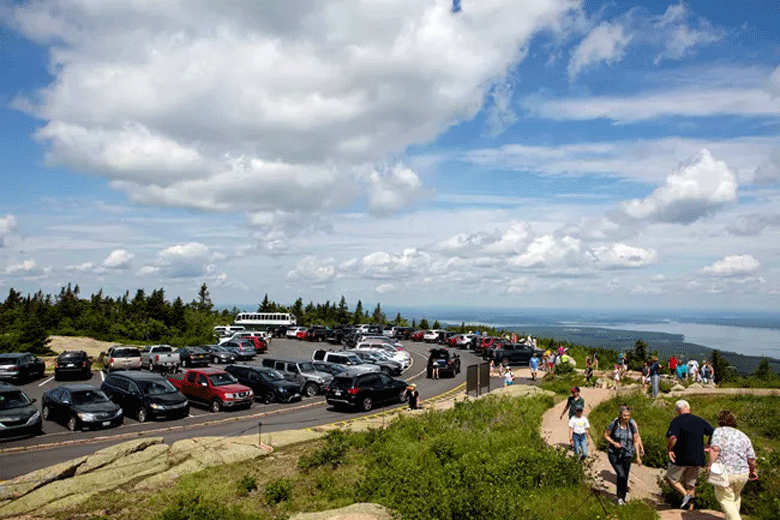What happens when Acadia has a “bad air” day?
The prevailing winds responsible for giving Downeast Maine its nickname have led some to grant the state a less than flattering moniker: “The tailpipe of the United States.”
Like exhaust flowing through a tailpipe, clouds of emissions from industrial areas or coal-fired power plants can be blown eastward and up the Atlantic coast. While some of the pollution dissipates en route to Maine, the emissions are recharged as the clouds blow over industrialized and major metropolitan areas along the I-95 corridor.
Without pollution, visibility in the park would be 110 miles on a clear day.
These air masses are in part made from gasses like nitrogen oxides and volatile organic compounds, or VOCs. When nitrogen oxides and VOCs are heated by sunlight, they react and produce a host of different compounds, including a relatively unstable molecule made up of three oxygen atoms called ozone. While ozone in the upper atmosphere is helpful to humans—it absorbs harmful ultraviolet rays from the sun—ground-level ozone is harmful to both human and plant health.
High ozone levels and resulting “bad air” advisories encouraging people to limit outdoor activities are most common during the summer months. Local vehicle traffic and air temperatures are at their highest, providing both the building blocks for ozone and ample energy to produce it.
“Ozone is just one of the ingredients in the soup of pollution,” says Bill Gawley, the biologist who manages Acadia National Park’s air monitoring program. The clouds of pollution blowing through “the tailpipe of the U.S.” often include other particulates like ammonium sulfate, ammonium nitrate, and soot, which, like ozone, can be harmful to respiratory health. These particulates also threaten another one of Acadia’s natural and cultural resources—visibility—by scattering and absorbing sunlight.
We owe the brilliant blue of summer skies to molecules in the atmosphere like oxygen and nitrogen that scatter sunlight. As rays of sunshine hit these air molecules, the light is scrambled into what your eyes perceive as color. And light absorption is helpful, too; molecules high in the atmosphere, like natural ozone, absorb ultraviolet radiation and other types of energy from the sun that can be damaging to skin.
But when pollutants scatter and absorb light, the result is a hazy sky with limited visibility. Without pollution, visibility in the park would be 110 miles on a clear day, which means you could see Mount Katahdin from the top of Cadillac Mountain. With the effects of pollution, visibility generally peaks at around 90 miles (along with rare views of Mount Katahdin), getting as low as 50 miles on high pollution days. At 50 miles, you could see just across Penobscot Bay to Camden Hills.
There are natural sources of visibility-hampering particles, too. During fire season, winds coming from the northwest carry in smoke from wildfires in Canada and the Pacific Northwest.

And there are local sources of haze causing pollutants, like industries with incinerators or smokestacks, regional forest fires, and vehicle and ship traffic. Local particulates are higher in the winter when homes use oil and wood burning stoves.
“Although they each seem like a drop in the bucket, cumulatively, that stuff all builds up,” says Gawley.
Acadia is designated a Class I area under the Clean Air Act, giving the park service the ability and responsibility to monitor and protect air quality and visibility. Though visibility has improved in the park since the 1990s, ozone levels have stayed the same.
Gawley sees continued nationwide monitoring as a crucial way to help air quality in Acadia continue to improve.
“Here in Acadia we’re part of a network, and that’s what gives power to our monitoring. When Connecticut detects bad air, we know it won’t be long until we sense it here in Acadia, too,” he says.
Educating visitors on the current state of Acadia’s air quality is another essential tool in improving air quality over the long term.
“It’s important that visitors know that much of the pollution we encounter here is generated someplace else, that everything is connected. We can’t build a dome around Acadia. How can we preserve the park if we don’t preserve the air anywhere else in the country?”
Olivia Milloway served as the Cathy and Jim Gero Acadia Early Career Fellow in Science Communication at the Schoodic Institute and is now a Fulbright student grantee studying marine biology at the Smithsonian Tropical Research Institute in Panama. She may be reached at omilloway@gmail.com.





